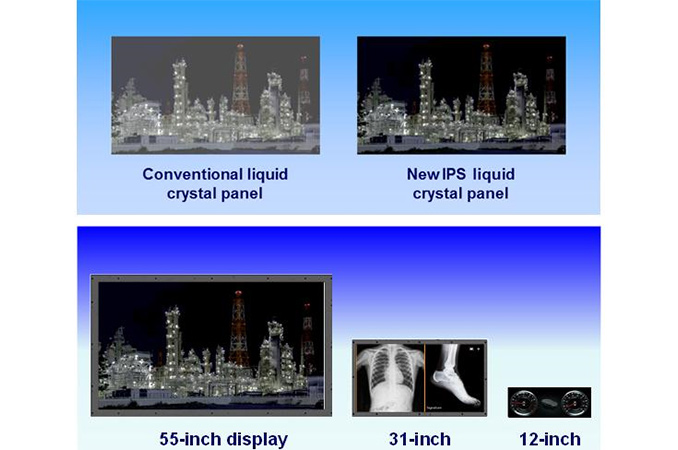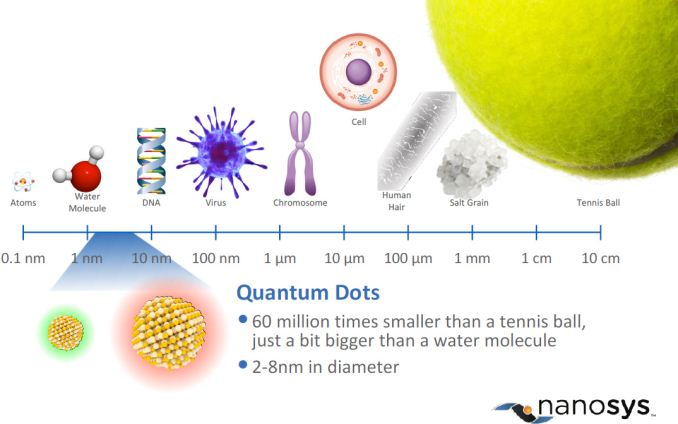Panasonic Develops IPS Panel with 1,000,000:1 Contrast Ratio, 1000 Nits Brightness
by Anton Shilov on December 1, 2016 12:10 PM EST
Panasonic has developed a new type of IPS liquid crystal panel that has a 1,000,000:1 contrast ratio, as well as a peak brightness of up to 1000 nits. Many LCD displays often advertise such contrast ratios which are measured against a dynamic backlight and are essentially meaningless, but in this case Panasonic is talking about the static contrast ratio of the display, which only reaches as high as 2000:1 on a typical IPS display. Little information is available about the technology at this point, but Panasonic claims that it is achieved by implementing pixel-by-pixel control of backlight intensity and that panels featuring the tech can be produced using contemporary LCD manufacturing facilities.
One of the key advantages that OLED displays have over LCD displays is extremely high contrast ratio that results in superior blacks. The reason why OLEDs can display deeper blacks is simple: such panels do not use backlighting and can completely switch pixels off when they need to display blacks. By contrast, LCDs use backlighting that cannot be turned off on a pixel-by-pixel basis, which is why in many cases blacks look like dark greys.
In the most optimal case, an LCD display will use full-array backlighting, where there are several LEDs placed directly behind the liquid crystal layer. This allows for a degree of control by performing local dimming of certain areas, which is how LCD televisions have managed to meet the standards required for HDR certification. However, the precision of the backlight control is not close to that of an OLED display which works at the pixel level. Even more common, especially in monitors and less expensive televisions, is the use of edge lighting where LEDs are placed along the edges of the display and the light is distributed across the panel using a guiding plate, which means you can really only control the overall brightness across the entire display.
As it appears, Panasonic has found a way to substantially increase contrast ratio of IPS LCDs using a high-brightness backlight and a special layer of light-modulating cells that enable pixel-by-pixel control of backlight intensity. These cells are made of light-tolerant liquid crystal material that has different light-transmission properties compared to those used in the display cells. The layer of light-modulating cells is placed between the backlight and the LCD cells and thus can control light leakage. At a high level, one could think of them like gates placed behind each pixel on the display.
Panasonic does not reveal many details about its light-modulating cells, but since it uses the term “cells”, it clearly indicates that we are dealing with a relatively thick layer of liquid crystals, not a thin layer of quantum dots (you can see an illustration from Nanosys (a company that produces quantum dot films that are currently used on Samsung TVs and displays) to compare “cells” versus “quantum dots”).
Usage of a high-brightness backlight and a layer of light-modulating cells enable Panasonic to build display panels with up to 1000 nits brightness as well as a static contrast ratio of 1,000,000:1. These figures mean that a black level of 0.001 nits should be possible, which is well beyond what even the best full-array backlit LCD displays can offer today.
Panasonic claims that the addition of the layer can be done using the existing equipment for LCD manufacturing, but it's not clear how costly the technology will be to implement or if it requires further components to be added to the LCD stack. The company plans to offer displays featuring the new technology for various professional applications, such as video production, medical, automotive, engineering and so on. Given the positioning, it is obvious that the price of IPS displays with enhanced contrast will be well above that of mainstream monitors.
Panasonic intends to start sample shipments of its new monitors in January, 2017, so the commercialization of the technology will not be too far off.
Related Reading:
Source: Panasonic












50 Comments
View All Comments
dwade123 - Thursday, December 1, 2016 - link
LCD keeps on improving. Amazing tech. Can't say the same about one-trick pony Plasma crap.Hulk - Friday, December 2, 2016 - link
Plasma was a good "bridging" technology from CRT's to LCD's I think. But I have to admit they never appealed to me.3DoubleD - Friday, December 2, 2016 - link
Plasma was great, but it maxed out it's potential with regards to resolution and thinness. I bought one of the last great plasma TVs before they discontinued production, a Panasonic ST60. It is still one of the best pictures I've seen, LCD cannot touch it. This new technology might finally bring LCD into the picture quality realm of plasma, but with the benefits of higher resolution and quantum dot assisted wide gamut color. We might finally get a worthy successor to plasma, so long as they can tighten LCD response times. OLED doesn't seem like it will ever be a good laptop or TV display technology, it has worse wear and brightness problems than plasma ever did and it costs a boatload.KoolAidMan1 - Sunday, December 4, 2016 - link
Plasma was a dead end in terms of size and pixel density. If we're talking about image quality then LCD can't come anywhere close, especially if we're talking about late model Panasonics. Those are still the best 1080p HDTVs around. OLED is the next big hope for high quality HDTV and its what I would get right now if I was looking for a 4k set. The LG sets are pretty great, I'm just waiting until I can get an 85" for less than the price of a car.darkich - Friday, December 2, 2016 - link
Not sure if LCD's are even worthy investing any more.Seems that this will add some thickness to the panel, which will further emphasise the amoled thinnes advantage. And there are other amoled advantages besides contrast - response time, and lower production prices when mass produced.
haukionkannel - Sunday, December 4, 2016 - link
It depend on price.If normal 27" monitor cost 250$
and this hight contrast cost 600$
and amoled cost 1500$
There is a room for it. Large amoled panels Are still very expensive. So if this douples the price of normal lcd screen it still is much cheaper than amoled.
MrSpadge - Friday, December 2, 2016 - link
"but since it uses the term “cells”, it clearly indicates that we are dealing with a relatively thick layer of liquid crystals, not a thin layer of quantum dots"Anton, in IT a "cell" can be a logical unit of any size, totally unrelated to biological cells. Consider e.g. a standard cell in circuit layout with maybe 4 fins. The required area would be about (200 nm)² in a modern process.
Penti - Friday, December 2, 2016 - link
Hasn't Panasonic shuttered their Himeji plant? So what makes them relevant in this field today? Sharp is the only one making large panels in Japan now.scb6 - Wednesday, December 7, 2016 - link
The Himeji Gen 8.5 facility is still operating. I was there a few months ago.Penti - Saturday, December 10, 2016 - link
From what I gather it is for a while longer, but it was suppose to close back in September according to news reports in Japanese media. There was conflicting reports though, and I'm pretty sure they where suppose to stop making large panels (for TVs) at least. Which leaves some of their professional and medical lineup I guess. That removes much of the relevancy though. At least compared to Sharp that makes panels in anything from phones to large UHD-TVs and professional monitors.Would like to see some reporting on what Panasonic's plans are going forward... It would be fun to see them recover some of their business rather then just die as every other Japanese manufacturer.